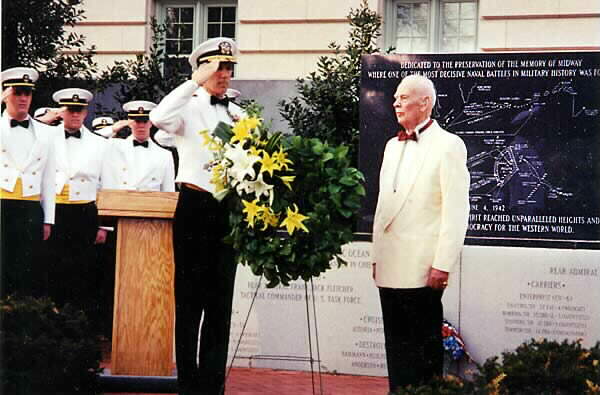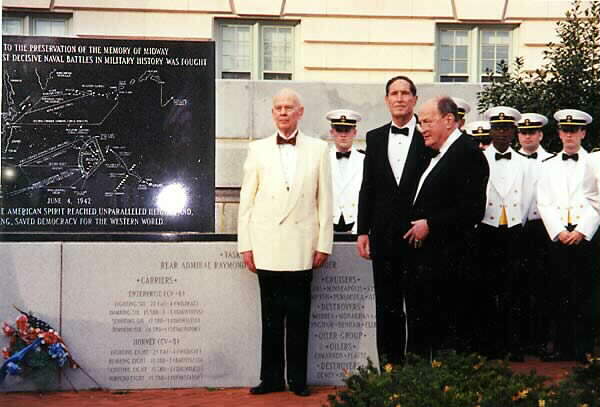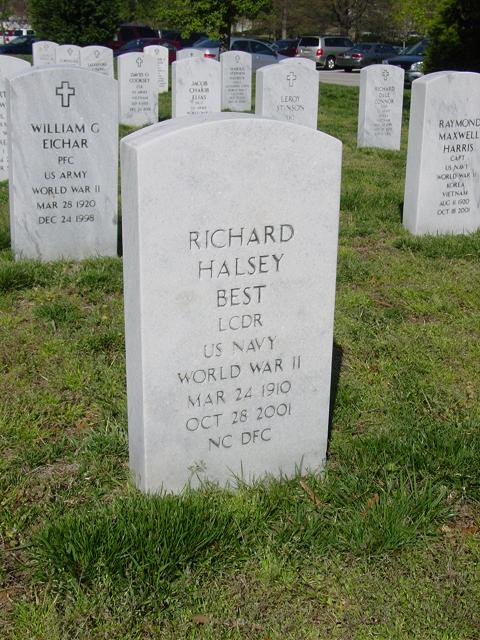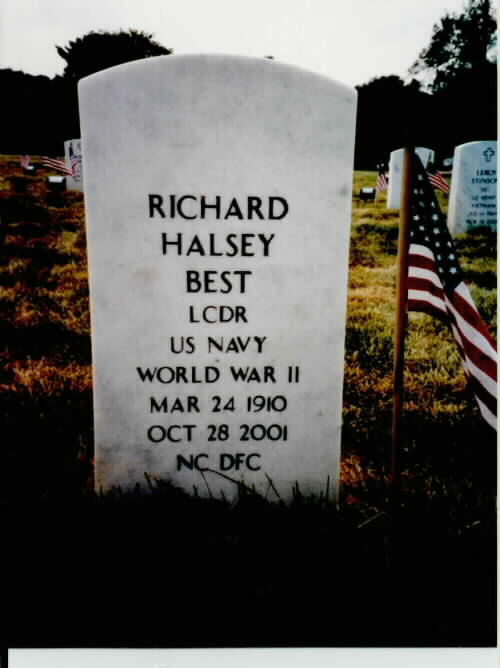Mr. Patterson:
I thought you might be interested to know that I can confirm that Lieutenant Richard H. Best, United States Navy, is buried at Arlington National Cemetery (Sec. 54, Lot 3192). I personally saw his grave on a recent visit. Lieuenant Best died on 28 Oct 2001 and was a 1932 graduate of the Naval Academy.
Lieutenant Best was the Commanding Officer of Bomber Squadron 6 (VB-6) at the Battle of Midway in June 1942. He led his planes on an attack on Japanese carriers that eventually sank these carriers. He was awarded the Navy Cross for his actions.
Gerald Shewan
Montgomery Village, Maryand
From a press report: 3 November 2001:
Richard H. Best, a former Navy bomber pilot who scored hits on two of the four Japanese aircraft carriers sunk in the critical Battle of Midway during World War II, has died. He was 91.
Best, a retired Security Manager at the Rand Corporation, died October 26, 2001, in Santa Monica, California.
The Battle of Midway–June 4-6, 1942–is considered the decisive battle of the war in the Pacific.
Before the battle, according to experts at the Naval Historical Center in Washington, the Japanese were on the offensive and had planned to capture Midway to use it as an advance base and entrap and destroy the U.S. Pacific Fleet.
But the Pacific Fleet surprised the Japanese forces and sank its four carriers, which had attacked Pearl Harbor only six months earlier. After the victory at Midway, the Allies took the offensive in the Pacific.
For his actions in the battle, Best received the Navy Cross and the Distinguished Flying Cross.
“He exemplified the young Navy pilots who turned the tide of the second world war,” said Jack Green of the Naval Historical Center.
“He never bragged about it, but he was obviously very proud of it because he would tell of his experiences to groups such as ours,” said Matthew H. Portz, a retired Navy Captain who, along with Best, belonged to the Order of Daedalians, the national fraternity of military pilots.
Born in Bayonne, New Jersey, Best was inspired to become a pilot by listening to the exploits of air veterans of World War I. He graduated from the U.S. Naval Academy in 1932, served on the light cruiser Richmond and began flight training in 1934. He later taught instrument flying and evaluated torpedo bomber tactics in Pensacola, Florida.
In June 1940, Best returned to the fleet and requested to be assigned to dive bombers.
“I knew that I could make the most contribution as a bomber rather than a fighter,” he told The Hook, a journal of carrier aviation, in 1996.
By mid-1942, Best was an experienced combat pilot assigned to the aircraft carrier Enterprise in the Pacific.
Portz, who interviewed Best recently for an upcoming article in the Order of Daedalians' quarterly magazine, said that the Americans had broken the Japanese code and learned that the enemy fleet was on its way to Midway.
On the morning of June 4, 1942, the Enterprise and two other American carriers–the Yorktown and the Hornet–were a few hundred miles from Midway Island when a patrol plane spotted Japanese aircraft carriers and their escorts heading toward the island.
That morning, Portz said, torpedo bombers from the three American carriers attacked three of the Japanese carriers and were almost wiped out by Japanese fighter planes and anti-aircraft fire.
But the attacking American torpedo bombers drew down the enemy fighters close to the water, Portz said, and while the Japanese fighters were attacking the torpedo bombers, the American dive bombers were able to hit the Japanese carriers.
Bombers from the Enterprise hit the Akagi and the Kaga. Dive bombers from the Yorktown hit the Soryu.
Of the 15 planes in Best's squadron, Portz said, only three returned to the Enterprise in good condition. A fourth plane came in later but was badly shot up.
That afternoon, Best and his remaining squadron members and another Enterprise bomber squadron went after the Hiryu, the one Japanese carrier that had escaped being hit in the morning.
Best and his squadron succeeded in destroying it, but unlike the morning mission when the Japanese fighters were down low defending against the American torpedo bombers, they were aloft.
“Hiryu threw everything she had at us,” Best told Portz. “I never tried to look where my bomb hit: she was shooting, the battleships were shooting, and the Zeros were swarming around. I dropped all the way to the deck to get out of there.”
Although Best returned unharmed after a day's work in hitting the Akagi and the Hiryu, the Battle of Midway turned out to be his last.
After returning to the Enterprise, he began coughing up blood and developed a fever. He was transferred to the hospital in Pearl Harbor, where X-rays showed cloudy spots on his lungs.
While flying the first mission during the Battle of Midway, a faulty oxygen canister had created gases that turned to caustic soda. He had breathed in the soda to clear it out. And the caustic soda, he was told, had activated latent tuberculosis.
“I knew my career was dead,” Best told Portz. “I never flew again.”
After undergoing 32 months of treatment, Best retired from the Navy in 1944 with a 100% disability. Between ages 32 and 42, Portz said, Best spent four years in and out in the hospital recovering from tuberculosis.
After the war, he worked at Douglas Aircraft and in 1947 he joined the Rand Corporation.
He is survived by his daughter, Barbara Ann Llewellyn; his son, Richard Halsey Best II; and a grandson.
Interment will be at Arlington National Cemetery.
Hero from Battle of Midway Dies
Story Number: NNS011106-16
Release Date: 11/6/2001 4:36:00 PM
By Ensign Frank Huffman, Chief of Naval Personnel Public Affairs
WASHINGTON (NNS) — Retired Cmdr. Richard H. “Dick” Best, who dramatically helped changed the course of World War II in the Pacific, recently died in Santa Monica, Calif. He was 91.
Best led dive bombing squadron VB-6 aboard USS Enterprise (CV 6). His action in the Battle of Midway helped destroy three Japanese carriers, turning the tide of the war in the Pacific.
On June 4, 1942, (then Lt.) Best's squadron was a member of Lt. Cmdr. Wade McClusky's Enterprise Air Group. His group of about 16 planes combined with Cmdr. Max Leslie's USS Yorktown (CV 5) Air Group, which by fate arrived at virtually the same time over the top of three Japanese carriers — Akagi, Kaga, Soryu. Their unintended rendezvous doubled the size of the U.S. strike force, which led to fatal blows to the three ships — all veterans of the attack on Pearl Harbor.
Best's squadron of Dauntless scout bombers became separated with the unexpected arrival of McCluskey's bombers. Splitting his force, Best led the 1st Division of three planes from the southwest against Akagi. Seeing the yellow flight deck emblazoned with a large red circle, Best dropped his 1,000-pound bomb from 2,500 feet, scoring a hit abreast of the bridge at 10:22 a.m., followed in succession by hits from his two partners, leaving the ship a wreck. His squadron mates in the 2nd Division hit Kaga, contributing to the carrier's sinking.
Best, a 1932 graduate of the U.S. Naval Academy, re-grouped what was left of his squadron and headed for USS Enterprise. Landing with only 30 gallons of fuel to spare, the 32-year-old squadron leader reported to Adm. Admiral Raymond A. Spruance that three carriers were burning but a fourth (Hiryu) had not been touched.
Later that day, Best became sick. During pre-flight, he was checking his oxygen levels when he inhaled gas fumes. Although he cleared his senses well enough to participate in the attack, the veteran Navy flyer had activated latent tuberculosis; his career in the military would soon end.
“It's unfortunate dad's career ended after Midway, but he vividly shared his memories with people until the last days of his life,” said his son, Richard Best II, an Army veteran. “We had historians calling all the time and dad contributed to numerous books on the Battle of Midway; too many to mention.
“Dad was proud of his service, his men and the other people of his generation,” he added.
Best's contributions to this battle earned him the Navy Cross with the following citation:
“For extraordinary heroism and distinguished service in the line of his profession as Squadron Commander of VB-6. He led his squadron against the Japanese invasion fleet during the Battle of Midway, June 4-6, 1942, with such boldness, determination and utter disregard of personal safety that he contributed in a large degree to the magnificent victory of our forces. His conduct throughout was in keeping with the finest traditions of the Naval service.”
After medically retiring from the Navy in 1943, Best went on to a successful career in the business world as a security manager for the Rand Corporation. A native of Bayonne, N.J., Best wore the Distinguished Flying Cross and is a member of the Naval Aviation Hall of Fame. He will be buried at Arlington National Cemetery.
BEST, RICHARD HALSEY
LCDR US NAVY
- VETERAN SERVICE DATES: 06/14/1928 – 03/01/1944
- DATE OF BIRTH: 03/24/1910
- DATE OF DEATH: 10/28/2001
- DATE OF INTERMENT: 12/06/2001
- BURIED AT: SECTION 54 SITE 3192
ARLINGTON NATIONAL CEMETERY


Michael Robert Patterson was born in Arlington and is the son of a former officer of the US Army. So it was no wonder that sooner or later his interests drew him to American history and especially to American military history. Many of his articles can be found on renowned portals like the New York Times, Washingtonpost or Wikipedia.
Reviewed by: Michael Howard


